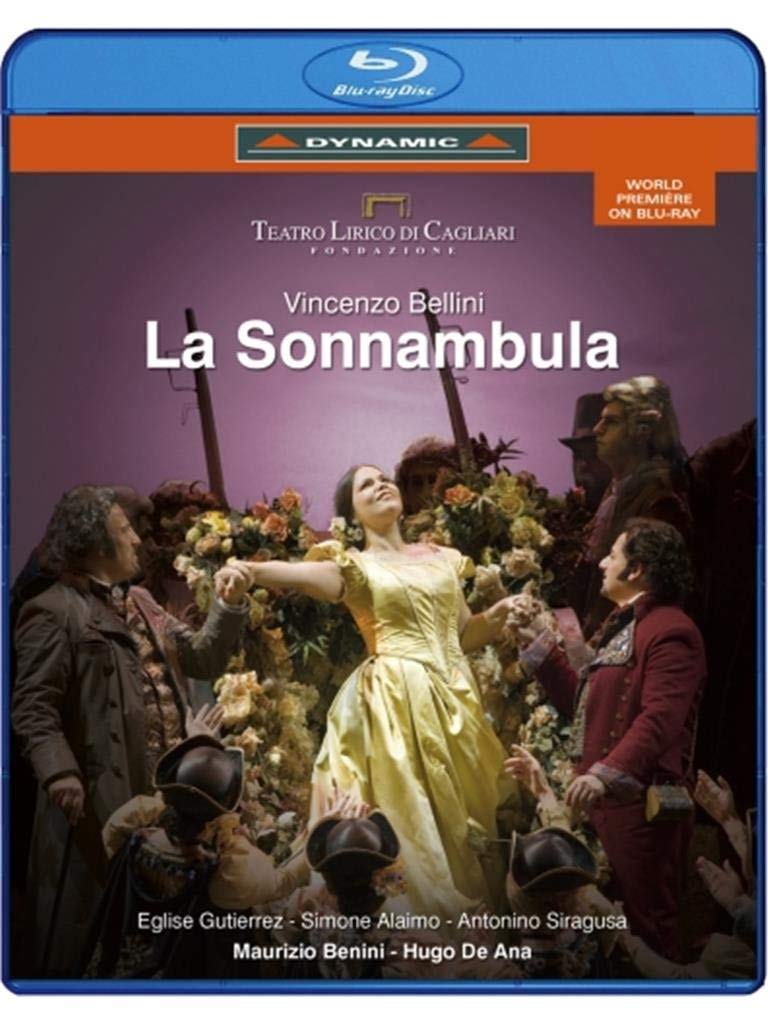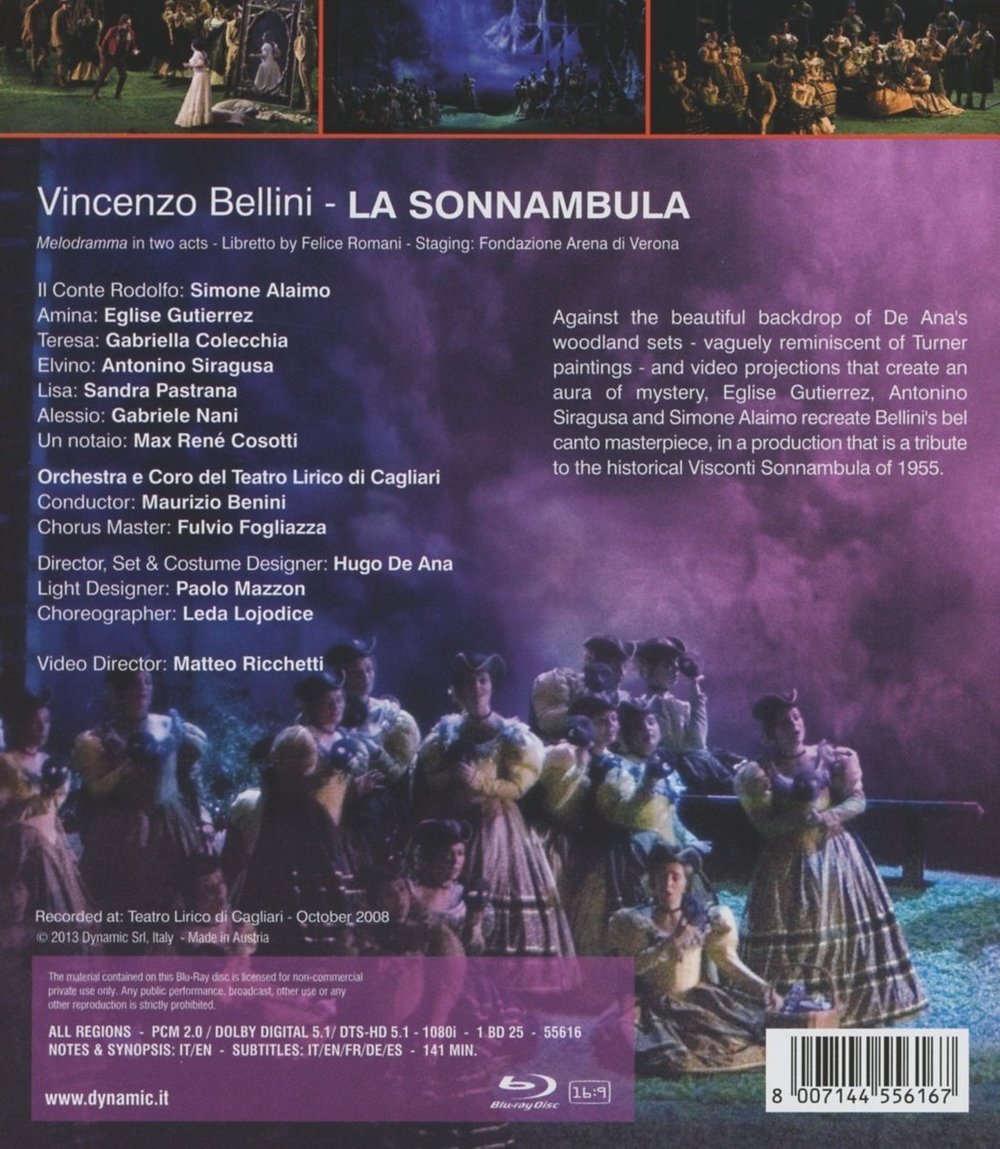

Bellini La Sonnambula opera to a libretto by Felice Romani. Directed 2008 by Hugo De Ana at the Teatro Lirico di Cagliari. Stars Eglise Gutierrez (Amina), Antonino Siragusa (Elvino), Simone Alaimo (Count Rodolfo),Gabriella Colecchia (Teresa), Sandra Pastrana (Lisa), Gabriele Nani (Alessio), and Max René Cosotti (Notary). Maurizio Benini conducts the Orchestra and Chorus Teatro Lirico di Cagliari (Chorus Master Fulvio Fogliazza). Sets and costumes by Hugo De Anna; lighting by Paolo Mazzon; choreography by Leda Lojodice. Directed for TV by Matteo Ricchetti. Sung in Italian. Released 2013, disc has 5.1 dts-HD Master Audio sound. Grade: A
For more about the characters and plot of La Sonnambula, see our previous stories about the La Fenice middle-of-the-road updating of this opera and the Stuttgart Opera psychologically realistic version. At Teatro Lirico, Hugo De Ana set out to use modern technology in an old-fashioned, romantic production that would give the audience some idea what it was like to be in a theater with Bellini in 1831. The main idea was to make what you see with your eyes in every scene as beautiful as what you are hearing with your ears. I was not enthusiastic about watching this because I feared I would be bored with a show designed to appeal to grandmothers. But Hugo is much smarter than that. This show will appeal to anyone with eyes who has ever been in love. In this review, I'll make a few comments, but mostly I hope the pictures will speak for themselves.
The stage consists of a rolling meadow in the Swiss Alps. Behind the meadow Hugo projects a wide variety of mysterious images that are designed to blend in with the action in the foreground (Bellini had to stage this 50 years before the electric light was invented). Here villagers gather to celebrate Amina's wedding to Elvino. Lisa (Sandra Pastrana) is facing the audience and about to sing her lament:
Alessio (Gabriele Nani) is in the center conducting his song honoring Amina. Note the change in the background:
Amina (Eglise Gutierrez) appears. The women in the chorus stand in formations like ballet dancers:
Elvino (Antonino Siragusa) gives Amina his mother's wedding ring:
A stranger (Simone Alaimo playing Count Rodolfo) arrives to stay in Lisa's inn. Through the telescope we see visions of things the stranger remembers about the village long ago:
Teresa (Gabriella Colecchia), Amina's mother, tells the stranger that the village is haunted:
After the betrothal party, Amina and Elvino have a lovers' fight. They make up and sing of how beautiful their lives will be together. Giant leaves enclose the couple in a magic bower:
Here Lisa makes her play for the stranger, who has turned out to be the Count who owns the nearby closed-up castle:
The Count's room at the inn is represented by windows that drop down onto the meadow. Through these windows we continue to see the mysterious images:
Here's the scene of grand confusion when Amina as sleepwalker wakes up in the Count's room. Poor Amina is compromised:
The villagers love Amina and want to rehabilitate her by asking for help from the Count:
I wasn't too surprised by this background image of a magnificent waterfall:
But I was intrigued by this image of a clipper ship in the Alps:
Amina and her mother rest near Elvino's farm:
For a few hours, Lisa thinks she will marry Elvino:
Note the image of vast mountains and a dark planet in the background:
The Count defends Amina:
Amina after her sleepwalking episode before the crowd:
She's still in love with Elvino:
And finally the lovers are back together:
It's so nice to see an opera where the words of the libretto perfectly match what happening on screen. For example, at one point the villagers sing, "Listen! Horses—somebody is coming." This makes sense in 1831, but not when the opera is updated to 1931 or 2013. In this Cagliari production, there are no jarring discontinuities, and the story slips by so smoothly! All the women singers are exceptionally good; the men are good enough even if Siragusa has been criticized by singing experts. The orchestra is fine as is the balance between the band and the singers. SQ is fine. Hugo De Ana succeeds beautifully with his directing, sets, and costumes all billowing with the winds of Bellini bel canto melodies. Grade: A.
Here’s a trailer from Dynamic:
OR























